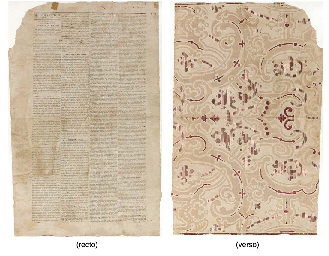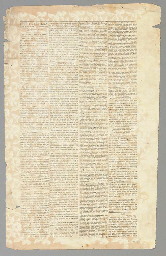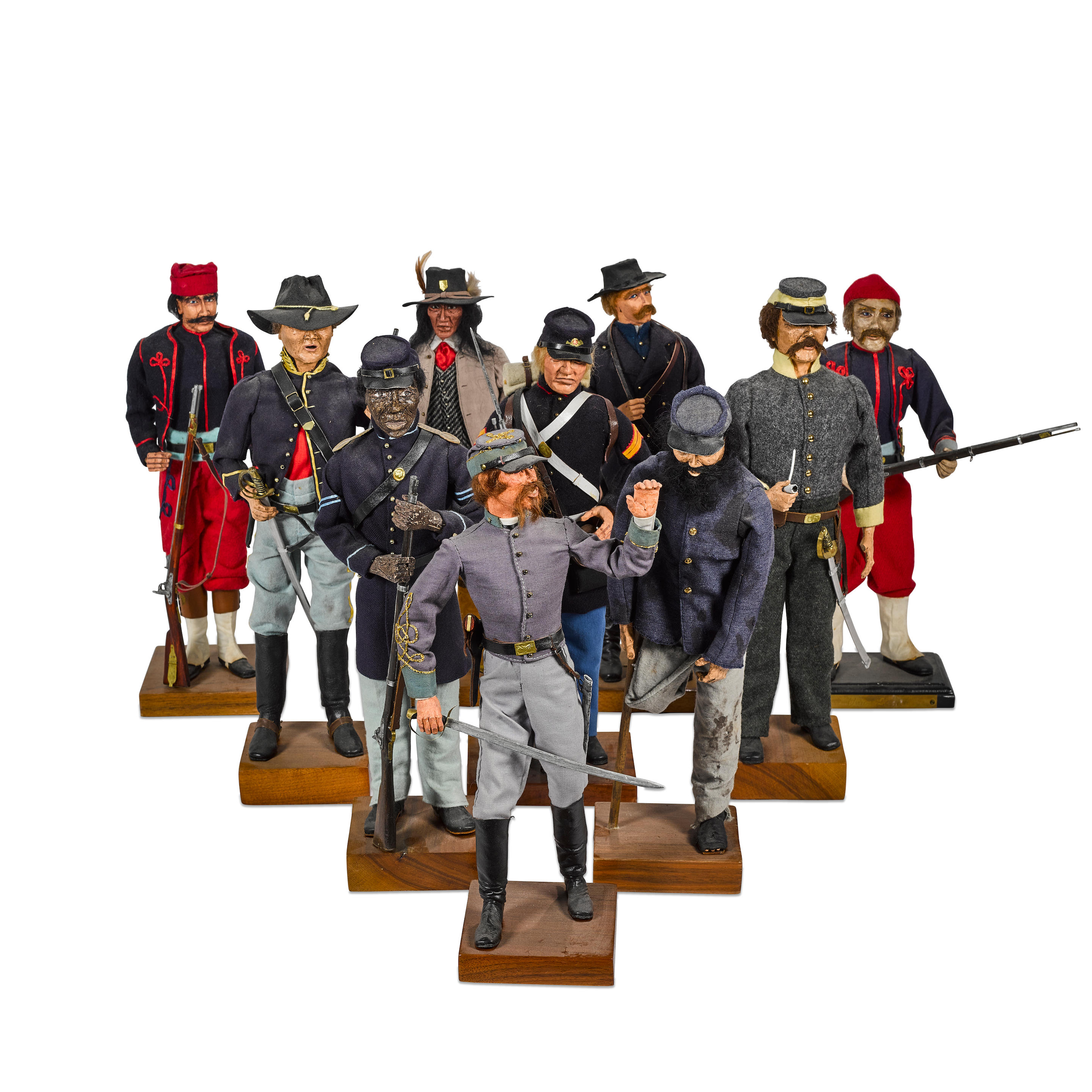On the back of 8.5 x 14 in. (legal) sheet, printed on verso with date of 1859 and printed name of W.O. Denegre, Assistant City Attorney crossed out (he served in that position from 1858-1860 before being elected City Attorney in 1860). Hand-drawn map of the river with title Bombardment of Forts Jackson & St. Philip. Noted are the forts, the raft across the river just below Fort Jackson, the position of the CSS Louisiana and Confederate River fleet, an "X" in the river below the raft with the label Position which Genl. Duncan proposed for the ironclad battery "Louisiana," position of Porter's mortar boats and "Enemy's gunboats." Additionally, there is a Lone Tree on the shore, a Point of Woods and an extensive cluster of buildings with the label Quaratine Statation [sic?] and Hospital occupied by the land forces of the U.S. the day the fleet passed up the River. In trying to divide the Confederacy, and gain access to the interior, control of the Mississippi River was crucial. New Orleans was also the largest city in the CSA and an active international port. Thus, early in the war, the decision was made to take New Orleans and control the "Big Muddy." The Confederate War Department was convinced from the beginning that the primary threat to New Orleans was from the north. They put most of their effort into those upstream forts - Island No. 10, Fort Pillow, Memphis. Little was done to reinforce Forts Jackson and St. Philip downstream from the city. In addition, there were few land-based troops and most of the city's young men had enlisted and been sent to other theaters, so there was really no defense in the city itself. The Confederacy was relying so heavily on the forts to control the river that they had very few vessels in the area. When the Union forces began gathering, they had the still-unfinished CSS Louisiana towed from the naval yard at New Orleans (her engines were not strong enough to navigate the current) to act as a floating battery. The Union decided to exploit these weaknesses and Flag-Officer David Farragut began assembling his forces at Ship Island in the Gulf. General Benjamin Butler was to lead a land-based attack once the river was cleared (but for the most part Farragut ignored the Army). But his foster brother, David Porter insisted that he could level the forts in 48 hours with his mortar schooners, so Farragut had to include them in his plans. It did not quite work out that way, but apparently the damage to the forts, much by way of fires started by the shelling, made life so miserable (they lost clothing, bedding, supplies), that the enlisted men at Fort Jackson mutinied and surrendered the fort. After several days of shelling, Farragut decided to make a run upriver. The previous day, his men cut a hole in the raft large enough to get ships through and about 3am, the Federal fleet made a run for it, hoping darkness and smoke from the mortars would save them from serious damage. Farragut was right, and with only the loss on one vessel, the fleet made it through and went on to attack New Orleans. The Confederate fleet lost a dozen vessels, including the Louisiana, which was scuttled rather than surrendered, and the CSS Manassas. On the back of the map is afixed a small newspaper report on the fate of the Manassas. According to Porter's report, she was abandoned, set afire and allowed to drift downstream. The Federals tried to save her (as a curiosity), but just as they got a line on her, the fire reached her only gun and she exploded and sank. A wonderful period view of a significant part of the Union plan. Condition: Folds, minor spots of foxing, particularly along the edges. Short tear near center fold, not affecting map. Overall, very good condition.
On the back of 8.5 x 14 in. (legal) sheet, printed on verso with date of 1859 and printed name of W.O. Denegre, Assistant City Attorney crossed out (he served in that position from 1858-1860 before being elected City Attorney in 1860). Hand-drawn map of the river with title Bombardment of Forts Jackson & St. Philip. Noted are the forts, the raft across the river just below Fort Jackson, the position of the CSS Louisiana and Confederate River fleet, an "X" in the river below the raft with the label Position which Genl. Duncan proposed for the ironclad battery "Louisiana," position of Porter's mortar boats and "Enemy's gunboats." Additionally, there is a Lone Tree on the shore, a Point of Woods and an extensive cluster of buildings with the label Quaratine Statation [sic?] and Hospital occupied by the land forces of the U.S. the day the fleet passed up the River. In trying to divide the Confederacy, and gain access to the interior, control of the Mississippi River was crucial. New Orleans was also the largest city in the CSA and an active international port. Thus, early in the war, the decision was made to take New Orleans and control the "Big Muddy." The Confederate War Department was convinced from the beginning that the primary threat to New Orleans was from the north. They put most of their effort into those upstream forts - Island No. 10, Fort Pillow, Memphis. Little was done to reinforce Forts Jackson and St. Philip downstream from the city. In addition, there were few land-based troops and most of the city's young men had enlisted and been sent to other theaters, so there was really no defense in the city itself. The Confederacy was relying so heavily on the forts to control the river that they had very few vessels in the area. When the Union forces began gathering, they had the still-unfinished CSS Louisiana towed from the naval yard at New Orleans (her engines were not strong enough to navigate the current) to act as a floating battery. The Union decided to exploit these weaknesses and Flag-Officer David Farragut began assembling his forces at Ship Island in the Gulf. General Benjamin Butler was to lead a land-based attack once the river was cleared (but for the most part Farragut ignored the Army). But his foster brother, David Porter insisted that he could level the forts in 48 hours with his mortar schooners, so Farragut had to include them in his plans. It did not quite work out that way, but apparently the damage to the forts, much by way of fires started by the shelling, made life so miserable (they lost clothing, bedding, supplies), that the enlisted men at Fort Jackson mutinied and surrendered the fort. After several days of shelling, Farragut decided to make a run upriver. The previous day, his men cut a hole in the raft large enough to get ships through and about 3am, the Federal fleet made a run for it, hoping darkness and smoke from the mortars would save them from serious damage. Farragut was right, and with only the loss on one vessel, the fleet made it through and went on to attack New Orleans. The Confederate fleet lost a dozen vessels, including the Louisiana, which was scuttled rather than surrendered, and the CSS Manassas. On the back of the map is afixed a small newspaper report on the fate of the Manassas. According to Porter's report, she was abandoned, set afire and allowed to drift downstream. The Federals tried to save her (as a curiosity), but just as they got a line on her, the fire reached her only gun and she exploded and sank. A wonderful period view of a significant part of the Union plan. Condition: Folds, minor spots of foxing, particularly along the edges. Short tear near center fold, not affecting map. Overall, very good condition.















Try LotSearch and its premium features for 7 days - without any costs!
Be notified automatically about new items in upcoming auctions.
Create an alert